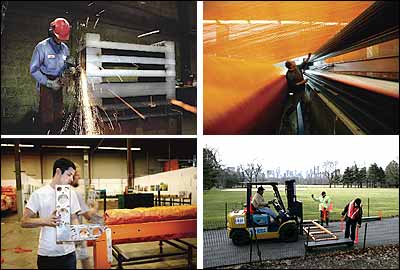
Clockwise from top left, manufacturing the bases in Springfield, Massachusetts; weaving the fabric in Germany; moving the bases to the park; assembling The Gates in Queens. Photo Credit: Wolfgang Volz
Bases
The Gates meet a construction building code’s 50-year return factor (meaning they would be able to withstand the most powerful gust of the last half-century) thanks to their steel bases, which weigh up to 837 pounds. More than 10 million pounds of raw steel went into making them. They were cut, welded, and painted by C.C. Lewis Co. in Massachusetts and Pennsylvania. Later, they’ll be sent to an industrial-recycling company.
Leveling Plate
A leveling plate with a pivot bolt, sandwiched between the steel base and the aluminum anchor sleeve, ensures that the vinyl poles stand perfectly upright even if the base sits on an incline.
Fabric
The J. Schilgen Co.—the same German firm that created the fabric for the artists’ Wrapped Reichstag, Umbrellas, and Wrapped Trees projects—wove 119,556 miles of thread to produce The Gates’ 1,006,620 square feet of rip-stop nylon. Ultimately, the fabric will be recycled. The material used on Wrapped Reichstag, for instance, was made into carpet padding.
Posts
The vinyl used to make the gates is half the cost and weight of metal. And the saffron color is mixed right into the plastic, eliminating the need for painting. The North American Profiles Group near Poughkeepsie produced the 60 miles of square vinyl tube, and sent it to the assembly plant in Queens to be cut into the sixteen-foot verticals and the horizontal poles, which vary in width from five feet six inches to eighteen feet, depending on the walkway.
Assembly
The real engineering feat of The Gates is the simplicity of the assembly. Think Ikea. Some components were preassembled in Queens. Workers there attached the fabric to a rope, which is inserted into a groove in the top pole. All that remains for workers in the park is to slide the other half of each aluminum corner sleeve into a vinyl pole, bolt it, hoist up the 135-pound structure and secure it with bolts. One day after all the gates have been erected, the workers will open the cocoon holding the fabric, letting the banners unfurl.
The Passion of the Christos
The Gates, in Central Park, 26 years
in the making, mile upon mile of billowing fabric, is the largest artwork
since the Sphinx. But what does it mean?
As Jeanne-Claude might say, what
a dumb question.
A Walk in the Park
Making sense of The Gates.